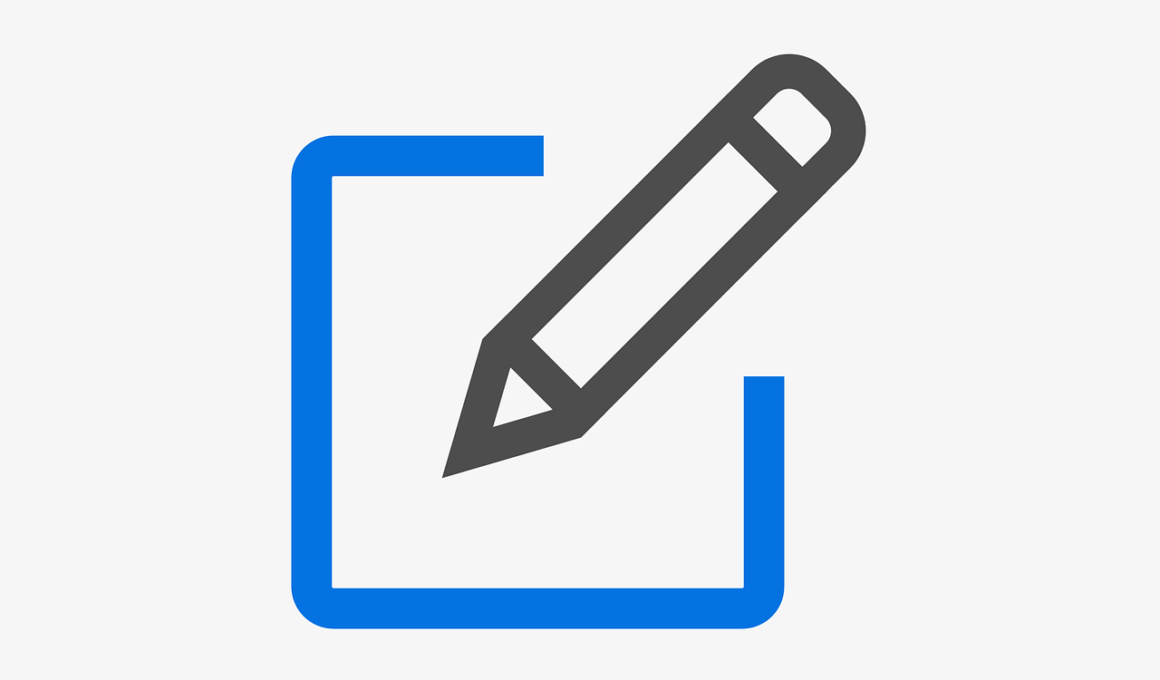How to Edit and Proofread Your Finance and Marketing Blog Efficiently
Editing and proofreading are two crucial processes in crafting a high-quality blog, especially in the finance and marketing sectors. The first step is to refine your content by eliminating unnecessary information and focusing on clarity. Ensure your message is direct, as your audience seeks practical insights. To maintain engagement, consider the layout of your blog. Use bullet points as needed to break down complex information into digestible chunks. Additionally, avoid jargon where possible, aiming for a conversational tone that appeals to a broader readership. Read your text aloud to catch awkward phrasing or pacing issues that you might miss during silent reading. It can be helpful to step away from your writing for a day and revisit it with fresh eyes. Furthermore, enlisting a peer for feedback can provide valuable perspectives on your blog’s coherence. Creating a checklist of common mistakes to watch for during your editing process can also improve your efficiency. Tools like Grammarly can be great for initial proofreading, but your final review should always be a manual one to ensure complete accuracy and professionalism in your finance and marketing blogs.
After content refinement, the next step involves deeper revisions and proofreading to ensure your blog resonates with readers in the finance and marketing industries. Focus on grammar and punctuation, as these elements are critical for professional credibility. Check for subject-verb agreements and common errors like misplaced apostrophes. Several online tools can help catch basic mistakes, but they are not foolproof. Therefore, it is essential to thoroughly check for contextual errors that automated tools might miss. Additionally, pay attention to inconsistencies in style and formatting throughout your blog, ensuring a visually uniform appearance. Each section should seamlessly transition to the next, enhancing the reading experience. Consider the consistency of your voice and tone as well; this helps establish your brand identity. Use headings and subheadings effectively to create a flow that guides readers through your content. Furthermore, employing whitespace judiciously makes your blog more visually appealing and less daunting to read. Conclusively, revisit your objectives for writing the blog—what do you want readers to take away? This mindfulness can dictate your editing decisions and determine the final modifications you make to your post.
Utilizing Feedback for Improvement
Leveraging feedback from colleagues or other industry professionals can significantly enhance the quality of your finance and marketing blog. When soliciting feedback, provide specific questions or areas of focus to ensure you receive constructive responses. Encourage reviewers to consider clarity, engagement, and overall effectiveness in conveying your message. You can opt for both informal and formal feedback sessions, giving recipients ample time to assess your work thoroughly. Moreover, being open to criticism allows you to identify blind spots in your writing. Embrace the editing suggestions you receive, as they often lead to deeper insights you might overlook. Implementing feedback also demonstrates professionalism and a commitment to improvement, building trust with your audience. It is wise to cultivate relationships with fellow finance and marketing bloggers who can provide ongoing support. Consider joining communities or networks where bloggers share edits and improvements. Periodic workshops can be beneficial too, as exchanging ideas motivates you to push your content’s quality further. Remember that feedback is not only about correction; it also validates what works well in your writing.
In addition to peer feedback, leveraging the insights gained from reader comments and analytics can enhance your editing processes. Pay attention to how readers interact with previous posts—what do they comment on, and which sections attract more attention? Using this data for future blogs can refine your focus on topics of greatest interest. Looking for common questions and areas that confuse readers can help shape your future content direction. Establishing connections with your audience also encourages them to feel invested in your blog, prompting more interaction. Implementing a comments section can enhance this aspect, fostering a community of engaged readers. Furthermore, monitoring your blog’s analytical data helps identify which finance or marketing themes resonate most. Regularly analyze your post’s performance metrics such as bounce rates and session durations. Understanding your readers’ preferences enables you to tailor content that consistently meets their needs. This creates a significant opportunity to establish authority within your niche. Ensure you integrate this feedback loop in your editing protocol consistently, allowing your blog to evolve with the interests of your audience over time.
Taking Breaks During Editing
Taking breaks during the editing process is crucial for maintaining mental sharpness. Working on a piece for extended periods can lead to diminishing returns; our brains can overlook mistakes due to familiarity with the text. When you step away from your writing, it allows your mind to reset and enables you to return with new insight. Aim to dedicate time for your editing and proofreading tasks while interspersing regular breaks. Fresh eyes can unveil unclear phrases, narrative inconsistencies, or grammatical errors that were previously missed. Furthermore, employing efficient techniques involves setting specific editing goals for each session, such as focusing solely on grammar during one review and structural issues during another. This segmented approach ensures that you tackle each aspect of writing thoroughly without feeling overwhelmed. Additionally, when you establish a structured routine that includes sufficient breaks, you can approach editing more systematically. Allowing time for your brain to rejuvenate ultimately enhances the quality of your final content. Deep focus then becomes less arduous and much more productive, ultimately producing a well-polished blog.
Once your editing phase is complete, it is time to conduct a final proofreading session before publishing the finance and marketing blog. Focus on minor details like spelling errors or formatting issues during this last stage. Ensure that your references, citations, or any financial data are accurate and current. Double-check hyperlinks where applicable, verifying they direct to the correct resources. Consistency in font style, size, and colors is essential for professionalism. A thorough final read-through is vital to catch any lingering mistakes. Reading your work backward can help identify typos or errors that may blend into the text when reading it normally. This technique forces you to approach the text differently and concentrate on individual words rather than the overall message. Consider using tools like Hemingway or ProWritingAid for an additional layer of analysis, focusing on readability and style. After making these final adjustments, take a moment to review your blog’s overall flow and ensure it achieves your original objectives. Confidence in your editing process paves the way for a successful publication.
Final Thoughts on Editing
The editing process may seem tedious, but it plays a pivotal role in producing a top-tier finance and marketing blog. By regularly applying the techniques discussed, you will create engaging and valuable content for your readers. Consistency in your approach will ensure that your blog remains polished. Embrace ongoing learning; industry trends shift quickly, and keeping your content relevant is essential. Use your editing journey as an opportunity to refine your knowledge and skills. Equip yourself with various tools and strategies to streamline your proofreading process. Moreover, networking with other writers can provide inspiration and guidance in navigating this iterative process. A well-edited blog opens doors not only to a broader audience but positions you as an authority in your field. Remember that quality content holds immense value; investing time in editing underscores your commitment to excellence. Ultimately, through dedicated efforts, your finance and marketing blog will evolve to reflect your unique voice while providing significant insights to your readership.
In conclusion, mastering the art of editing and proofreading for your finance and marketing blog empowers you to deliver clear and concise messages effectively. Commit to the editing process as a vital step towards achieving a professional standard in your writing. Your readers will appreciate the effort you put forth, as it reflects positively on their experience and the information they gain from your blog. Ensure that your editing routine is manageable and tailored to fit your personal workflow while allowing sufficient time for thorough revisions. Celebrate your accomplishments, both big and small, as each piece brings you closer to mastering your craft. Over time, applying these editing and proofreading techniques will become second nature, and your confidence will grow. A consistently well-edited blog can create loyal readers who value the insights you provide. Staying up-to-date on the latest trends in the finance and marketing sectors also aids in keeping your content relevant. Remember, editing is an ongoing journey, not a destination; every new blog is a chance to apply and enhance your skills. Ultimately, develop your unique style and voice, ensuring it shines through in every piece you create.


